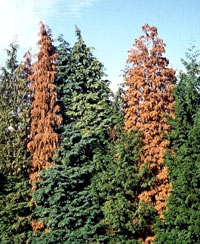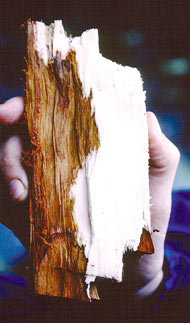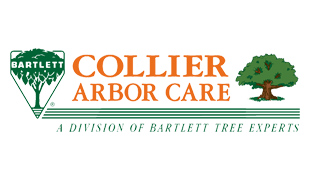|

Port Orford Cedar hedge dying from Phytophthora. Phytophthora Root RotDownload a PDF of this articlePlants AffectedThere are many hundreds of plant species that are attacked by Phytophthora root rot. Ornamental trees: cherry, dogwood, holly, madrone and oak. Conifers: arborvitae, cypress, juniper, Port-Orford cedars, Pines, true firs, yew. Fruit trees: Apple, cherry and peach. Shrubs: Andromeda, azalea, boxwood, heather, rhododendron, salal. Symptoms/DamageDiseased plants will commonly be found in heavy clay soils and poorly drained areas of the landscape. Affected plants will have reduced vigor and growth, yellowing of the leaves, then wilting, rapidly turning brown, resulting in death of the plant. Infected trees may decline slowly over a several year period or they may suddenly wilt and die rapidly after the first warm weather period. Some species of Phytophthora will attack above ground portions of plants such as branches of rhododendrons or tree trunks as in sudden oak death. RootsYou will need to examine the root tissue several inches below the soil line. Using a knife remove the outer bark tissue to expose the inner wood. A diagnostic reddish-brown discoloration of diseased tissue with a sharp line separating the healthy white tissue will be observed. With advanced infection most of the smaller roots will have black, dead tissue and often times an unpleasant smell. Life CycleThis soil-borne fungus survives in infected wood or as thick walled resting spores. These spores can survive for long periods of time (many years). Then when soil is saturated with water the thick-walled spores germinate to produce swimming spores. These spores swim thru soil water infecting susceptible small root tissue or by splashing water and infecting branches or leaves. The swimming spores can be spread long distances by surface water runoff or by spread of contaminated soil or plants. After root infection the fungus grows and spreads throughout the inner bark of the roots and into the lower stem killing the plant tissue. ManagementCulturalAvoid sites that drain poorly or are periodically flooded. Improve drainage by installing underground drains or breaking up hardpans and compacted soil. Remove infected plants and infected plant parts. Install plants that are resistant to Phytophthora generally plants that are adapted to swampy conditions. Some examples include tupelo, aspen, serviceberry, sweet bay magnolia, red twig dogwood to name a few. OrganicA preventative application of beneficial mycorrhizae has been demonstrated to help protect roots from Phytophthora infections. ChemicalUse of approved fungicides can help manage Phytophthora but are seldom effective in reviving plants that have advanced symptoms and are wilting. Fungicides are most effective when combined with the cultural practices described above. |

Root infected with Phytophthora root rot -- note sharp line between brown (diseased) and white (healthy) tissue. |
|
Home |
Services |
The Arbor Advisor |
Garden Calendar |
About Us |
Fact Sheets |
Contact Us |
Site Map Collier Arbor Care Portland 503-722-7267 Vancouver (360) 693-6056 Site contents and design ©2013 Collier Arbor Care |





